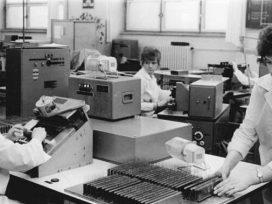“While I orbited the earth in the spaceship,
I saw for the first time how beautiful our planet is.
Mankind, let us preserve and increase this beauty,
and not destroy it!”
Y. A. Gagarin
Biography and myth
The tin space-toys of my childhood consisted of NASA rockets; my battery-powered, Japanese-made spaceship with the American national emblem and the inscription “U.S.A.F. – GEMINI X5” is still on my bookshelf. I also remember we children being woken up in the darkness of the night for the first moon landing and sleepily following this “world-historical” event on our black-and-white television set. When the Apollo landing craft finally settled on the surface of the moon and Neil Armstrong took the first steps, my father turned off the television and commented that the Americans might now on the moon, but that the first human being in the cosmos had been a Soviet Russian, Yuri Gagarin.
As with many other paternal hints and references, I soon mentally suppressed the name Gagarin. The space heroes of my youth were astronauts, while cosmonauts seemed second-class to me. Not until September 1997, during my first trip to Moscow, when I happened to witness the demolition of the space exhibition in the Cosmos Pavilion, did I start taking a serious interest in the Soviet icon Gagarin.
Yuri Alekseyevich Gagarin was born on 9 March 1934 as the son of collective farm peasants in the village of Klushino, near Smolensk. After attending secondary school and being trained as an industrial mould-maker, he fulfilled his childhood desire of becoming a pilot by undergoing military flight training. In 1959, he was selected from 2000 applicants for training as a cosmonaut. Together with Gherman Titov, he was the best of 200 test pilots. Finally, he was appointed Cosmonaut No. 1, because of his “immaculate class origins”.
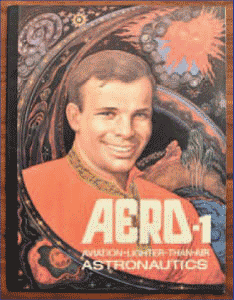 On 12 April 1961, a rocket weighing 287 tons rises from the launching pad. However only a few people know the secret of the name of the world’s first cosmonaut. Not even the wife and parents of the 27 year-old pilot have been informed as the space ship, marked Vostok 1, ascends into the sky. When it has circled the earth and 108 minutes later has landed on a Russian field, Gagarin becomes world famous. Immediately after the launch, the Soviet news agency TASS cables the announcement of the first manned space journey around the globe. The fact that the mission narrowly escaped disaster because the capsule almost burnt up on re-entering the earth’s atmosphere becomes known only decades later.
On 12 April 1961, a rocket weighing 287 tons rises from the launching pad. However only a few people know the secret of the name of the world’s first cosmonaut. Not even the wife and parents of the 27 year-old pilot have been informed as the space ship, marked Vostok 1, ascends into the sky. When it has circled the earth and 108 minutes later has landed on a Russian field, Gagarin becomes world famous. Immediately after the launch, the Soviet news agency TASS cables the announcement of the first manned space journey around the globe. The fact that the mission narrowly escaped disaster because the capsule almost burnt up on re-entering the earth’s atmosphere becomes known only decades later.
Two days after his flight, Gagarin is received in the Kremlin by Nikita Khrushchev, First Secretary of the Soviet Communist Party and Soviet Premier. His journey of several kilometres through Moscow in an open car adorned with flowers turns into a triumphal procession; masses of cheering people form an honour guard from the airport to the Red Square. While still in orbit, Gagarin has been promoted to major, and now the Order of Lenin and the Gold Star of a Hero of the Soviet Union are pinned to his chest. Half a century later, when you look at the old newsreels, the youthful officer with open shoelaces walking down the red carpet and leaping up the steps to the Lenin Mausoleum, saluting with a smile and announcing his return, looks more than ever as if he comes from a different universe.
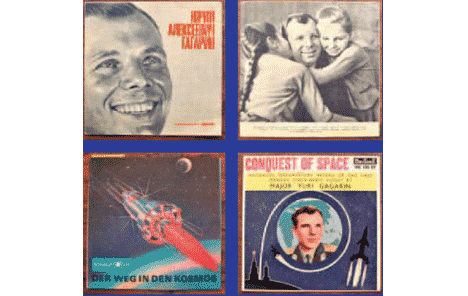
At first, Gagarin enjoys his popularity. Soon, however, he experiences the greatest possible contradiction between collective and individual. From nowhere he becomes a “pop star” in a system that defines the individual only as the product of society and in the long term is unable to cope with the singularity of a phenomenon of this dimension. The convinced communist is sent abroad as living proof of the superiority of socialism; for the masses, however, he embodies a utopia that reaches far beyond political systems. His answers to questions from reporters and the public are knowledgeable, quick-witted and humorous. If one speaks with cosmonaut colleagues, space engineers or other persons who have been in contact with Gagarin for short or long periods, professionally or in private, they all report of his charm and lack of vanity. Gagarin’s worldview even impresses his opponents. His modesty and thoughtfulness are legendary. Asked about the most difficult thing in his mission, he replies to an interviewer: “The most difficult thing is coping with the fame.”
The ruling gerontocrats, in the Sixties not only a phenomenon of the Soviet Union, look small and old next to Gagarin. This overburdening of ideological systems is also expressed in a document of 1962: during a visit to Austria, Gagarin appears on television with the talk show host Heinz Conrad, responding with wit and humour to the latter’s cheesy questions about the weather in space and other nonsense.
Someone who is early in recognising the religious aspect of Gagarin’s journey in space is the Catholic Communist Pier Paolo Pasolini. The final sequence of his newsreel montage La rabbia of 1963 turns Gagarin into the apotheosis of the Soviet Hero. In the race to the moon, the Soviet Union is still ahead by a whisker. Valentina Tereshkova is the first woman in space in 1963, travelling in Vostok 6, and in 1965 Alexei Leonov is the first to float freely.
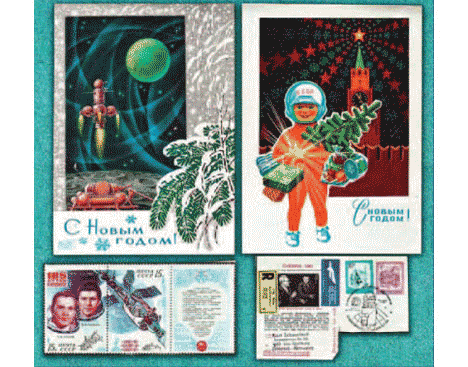 In the Soviet Union, the cult of the cosmonaut becomes an enormous phenomenon. Millions of postcards, postage stamps and badges with cosmonaut faces and cosmic motives are produced. The first space travellers are idolised like gods. In a survey conducted by the government newspaper Izvestia in 1966, Gagarin remarks that he feels uncomfortable being repeatedly represented in articles and reports on space travel as a hyper-ideal person.
In the Soviet Union, the cult of the cosmonaut becomes an enormous phenomenon. Millions of postcards, postage stamps and badges with cosmonaut faces and cosmic motives are produced. The first space travellers are idolised like gods. In a survey conducted by the government newspaper Izvestia in 1966, Gagarin remarks that he feels uncomfortable being repeatedly represented in articles and reports on space travel as a hyper-ideal person.
Gagarin is now deputy commander of cosmonaut training, but as Cosmonaut No. 1 he is excluded from training for more flights. Not until 1968 is he again active as a pilot. During a test flight on 27 March, he has a fatal accident, aged just 34. When his death is announced the following day, many people all over the world are shocked and burst into tears. At the burial ceremony at the Kremlin wall, the new head of government, Leonid Brezhnev, has his hand on the urn: Gagarin’s mentor, Khrushchev, was replaced long ago.
A memorial is erected at the crash site, 100 kilometres northeast of Moscow close to the village of Novoselovo. At the place where the aircraft drilled metres into the ground a 25-metre-high marble obelisk now points to the sky. The tops of the neighbouring birch trees were shaven by the stricken jet-plane and are now kept at that length. Shortly after his death, the town in which Gagarin spent his childhood and youth, Gshatsk, is renamed after him. In the neighbouring village of Klushino, a replica of his birthplace is erected as Gagarin’s mother Anna remembered it, and memorials are put up all over the entire country. Celebrations are held on 12 April and 27 March into the 1980s, especially on round-number anniversaries; hundreds of youth clubs and members of the military attend the ceremonies. Only after the end of the Soviet Union does the Gagarin myth begin to fade. Yet even in the era of toppling memorials, no Gagarin busts fall, and where they had corroded, they are now polished again.
“The fortune and the end of the laughing cosmonaut in the sign of the red star have far greater mythological power than the few steps taken on the moon by Neil Armstrong on 21 July 1969”, writes the theologian Adolf Holl in his book “The Laughing Christ”. “Wish fulfilment and crashes, as in the stories of Icarus and Phaeton, obviously have a stronger impact on the (male) unconscious than the US flag on the lunar rubble.”
Indeed, the son of simple kolkhozniks who got to be the first to view our planet from space is much more than just a historical mytheme of the faded Soviet Union. The journey of the space traveller reflects the triumph of technology in a century that believed in progress, together with all the archaic and religious codes that went with it. Yuri Gagarin seems predestined for such a symbolic role, and not only because of his personal appearance and his character. His biography is a passion story of the age.
The Cosmos Pavilion as a ruin of memory
Space travel is a conquest of territory, both real and imaginary. Cosmos implies distance, vastness, however “space” is available and ready for use. You just need to own it.
The enthusiasm for the cosmos unleashed by the first satellites Sputnik, Laika und Gagarin was catered to in the form of walk-through space exhibitions. The dimensions of spacecraft become comprehensible for a mass audience, the exhibited artefacts and cosmonauts, now back within the earth’s gravitational field, undergoing a complex process of sacralisation. The relics were now not the body-parts of saints but copies of rockets and space probes, while their passengers, the cosmonauts, seemed to have become divine.
The world’s biggest permanent space exhibition was installed in the Cosmos Pavilion on the site of the economic trade fair in Moscow. The steel-arched hallway tunnel, initially planned for the exhibition Mechanisation and Electrification of Agriculture in 1939, was enhanced with a big entrance portal and an enormous glass dome. Visitors were taken past the representations of central symbols of “scientific socialism” and, looking firmly ahead and upwards, led into the cathedral of sophisticated machines. There, floating above them in the bright dome, were the shining space vehicles, originally equipped for the voyage into utter coldness. Looking down from the top of the dome was the radiant apotheosis of the space traveller with the most human of faces: the oversized picture of the smiling Gagarin wearing a major’s uniform with the dove of peace. In 1967, a duplicate of Gagarin’s Vostok 1 was placed at the centre of the big round plaza in front of the pavilion, filling the empty space where work on a 30-metre-high statue of Stalin had been interrupted in 1959. “Vostok 1 replaces Stalin,” wrote Ingo Schauermann. “At the same time, the rocket breaks with the Soviet tradition of monumental propaganda and becomes a different kind of memorial, since now it is only the replica of a machine that no longer exists. In this sense, it is also a portrait. It portrays something different and is not what it claims to be, namely a rocket. Here, more than in any other place, the transition from the personality cult to the cosmos cult becomes manifest in the Soviet Union.”
The neglect and progressive demolition of the Cosmos Pavilion began at the end of the 1980s. First, the hall was used for holding parties, then as a showroom for luxury automobiles and racing cars, and for a long time after that as a electronics salesroom divided into separate booths. After the final disassembly and partial destruction of the space exhibits in 1997, the last functional change took place. Now, the former Cosmos Pavilion is used as a marketplace for simple garden tools. The conquest of space is now complete and the mechanisation and electrification of agriculture has reverted to spade and hoe. In the dome of the pavilion, Gagarin’s portrait fades into half-light and, out on the plaza, the rusting copy of his rocket points meaninglessly at the sky.
The stars are waiting for us. On the images of Alexei Leonov and Andrei Sokolov
Gagarin and many other Russian space travellers frequently stated that their “cosmic world feeling” was powerfully influenced by utopian literature such as that of Konstantin Tsiolkovsky. However, the manned space flights of the 1960s were also a strong inspiration for writers and visual artists. In this connection, an interesting phenomenon is the painter duo Leonov/Sokolov. Andrei Sokolov, a master of fantastic utopianism, integrated existing rockets, spaceships and land robots into his fantastic images. Alexei Leonov, the first person to walk in space and the commander of several space missions – also a participant in the Apollo-Soyuz Test Project of 1975 – adopted Sokolov’s painting technique, calling him his mentor, and committed his experiences of the cosmos to canvas in the style of Fantastic Realism. Numerous pictures resulted, sometimes in collaboration and sometimes as solo works.
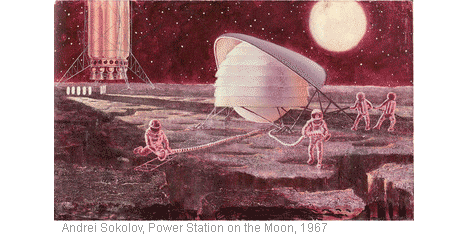
In 1967, on the fiftieth anniversary of the Russian Revolution and the tenth anniversary of the Sputnik flight, they were assembled thematically and exhibited internationally. In the introduction to the exhibition catalogue, Yuri Gagarin wrote under the heading “On space near to earth”: “For many, the start of the Vostok space ship seemed like a miracle. In fact, it was a product of the Soviet people and the truly herculean achievements of its engineers, technicians and workers. The space ship is a symbol of the century. It is a fusion of pure science, technological progress and our high level of development. I am sure that many of those who turn the pages of this catalogue – especially young people – will reach the moon, Mars and other planets and in this way personally experience the worlds shown in these pictures. And, perhaps they will discover much more as well. All the better. The world can only profit from that.”
Seeing differently. The view from the moon
The Austrian philosopher Günther Anders interpreted space flights as ideological amalgams. Anders describes the dozen years between Sputnik 1 and Apollo 11 as a key period in the socio-political development of the twentieth century. On the basis of a dichotomy between the heroic and the ignorant, he sees the Soviet cosmonauts Nikolayev and Popovich on their dual flight in 1962 as flying mummies who function merely as the anthropomorphisation of technology. The cosmonaut’s landing on earth thus appears as catching up with an achievement already overtaken by our standards of measurement: a view of the cosmos is followed by a “landing humiliation” for which no medal pinned to a breast can compensate. Cosmonauts and astronauts are interpreted as twins who undermined the schemata of thought and feeling in the Cold War and helped the insight emerge that “the transformation of humanity through technology, despite all borders, is the same both here and over there.” The Russian-American Soyuz-Apollo mission of the Seventies and the resulting construction of the international space station provide further evidence for this idea.
The Apollo astronauts’ view from the moon to the earth, simultaneously received by millions of television viewers, is interpreted by Anders as “the earth encountering itself”: “Not only did they encounter it, we experienced it as well. And since we remained back on the earth, and as earthly creatures are the earth, we may say in all fairness: for the first time – and this is a historical event of a completely new kind – the earth, standing before a mirror, became reflective, aroused to self-consciousness for the first time, or at least to self-perception. Because it saw itself from the outside for the first time, as an object, as what it would seem like to beings at a great distance from it, this first self-perception was associated with the total alienation of the perceived.” Anders’s coldly surgical analysis ends with a warning against total precision: “Compared with the minute detail and reliability of the Apollo 11 rocket, the quality of work and the reliability of the extermination camps was still crude and patchy. […] There is not the slightest reason to assume that our mutual destruction will be carried out any less precisely and succeed less perfectly than the earth-moon-earth flight. Anyone who happily applauds this success today is unknowingly applauding tomorrow’s performance of the final disaster, for which yesterday’s moon landing functioned as a dress rehearsal.” Anders’ historical pessimism is reinforced by the fact that the brain of the Nazi collaborator Wernher von Braun not only created Hitler’s still defective miracle weapon, the V2, but also perfected the American moon rocket. In Anders’ terms, failed missions such as Apollo 13 or the collapse of the Challenger spacecraft were merely setbacks in a historical period of grace, Gagarin’s narrow survival on re-entering the atmosphere and his early accidental death were nothing but an antithetic writing on the wall.
The KOCMOC Movement / Gagarin Group
The KOCMOC Movement was founded in 1997 in the Cosmos Pavilion (Russian: KOCMOC). The original intention was to save the bust of Yuri Gagarin, an aluminium representation of the cosmonaut approximately one-and-a-half-metre-high, from being sent to the scrap yard.
Once we had failed in this noble challenge, the action was turned into a virtual one, in Dadaistic fashion. From then on, the movement’s prime aim was to charm Yuri Gagarin’s smile onto the faces of women throughout the world and en masse. The group was organised according to the cadre principle of underground political movements, and at times more than sixty specialists worked on implementing this programme in various parts of the world. A wide variety of means were employed, mainly based on classical agitprop methods. Since 1998, on every 12 April, KOCMOC distributes numerous copies of a propaganda card. In addition, a comprehensive archive and library on the theme of Soviet cosmonauts and the iconography of Yuri Gagarin has been set up. In July 2007, a special unit (Sonderkommando) of the movement started the mission Vostok 1 lands on Red Square and flies on to the star city. The film Always Remember Juri Gagarin (2008), the radio drama Vostok 1 on the trail of Yuri Gagarin (2008) and a book publication document this action. Films and artefacts from the KOCMOC collection are displayed in the exhibition.
On 12 April 2011, Gagarin’s pioneering act has its fiftieth anniversary. The movement KOCMOC Group Gagarin will dissolve on this day. For all its partial successes, it has not succeeded in rediscovering the bust of Yuri Gagarin and bringing it to the exhibition Space. About a Dream at the Kunsthalle Wien. Nor, despite two frontal attacks from the Commander, has Vladimir Putin agreed to release the real Vostok 1 capsule.
However, Yuri Gagarin’s smile and his early death have made him immortal as an icon of the space age.
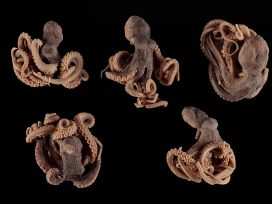
 On 12 April 1961, a rocket weighing 287 tons rises from the launching pad. However only a few people know the secret of the name of the world’s first cosmonaut. Not even the wife and parents of the 27 year-old pilot have been informed as the space ship, marked Vostok 1, ascends into the sky. When it has circled the earth and 108 minutes later has landed on a Russian field, Gagarin becomes world famous. Immediately after the launch, the Soviet news agency TASS cables the announcement of the first manned space journey around the globe. The fact that the mission narrowly escaped disaster because the capsule almost burnt up on re-entering the earth’s atmosphere becomes known only decades later.
On 12 April 1961, a rocket weighing 287 tons rises from the launching pad. However only a few people know the secret of the name of the world’s first cosmonaut. Not even the wife and parents of the 27 year-old pilot have been informed as the space ship, marked Vostok 1, ascends into the sky. When it has circled the earth and 108 minutes later has landed on a Russian field, Gagarin becomes world famous. Immediately after the launch, the Soviet news agency TASS cables the announcement of the first manned space journey around the globe. The fact that the mission narrowly escaped disaster because the capsule almost burnt up on re-entering the earth’s atmosphere becomes known only decades later.
 In the Soviet Union, the cult of the cosmonaut becomes an enormous phenomenon. Millions of postcards, postage stamps and badges with cosmonaut faces and cosmic motives are produced. The first space travellers are idolised like gods. In a survey conducted by the government newspaper Izvestia in 1966, Gagarin remarks that he feels uncomfortable being repeatedly represented in articles and reports on space travel as a hyper-ideal person.
In the Soviet Union, the cult of the cosmonaut becomes an enormous phenomenon. Millions of postcards, postage stamps and badges with cosmonaut faces and cosmic motives are produced. The first space travellers are idolised like gods. In a survey conducted by the government newspaper Izvestia in 1966, Gagarin remarks that he feels uncomfortable being repeatedly represented in articles and reports on space travel as a hyper-ideal person.


